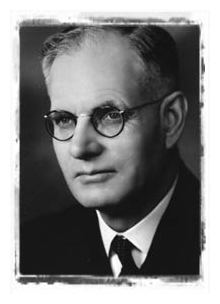John Curtin (1885-1945) John
Curtin was the first and only Australian Prime Minister to come from Western
Australia. Opposed to secession but sympathetic to the claims of the smaller
States, Curtin was out of office during the secession, having lost his seat
in the 1931 defeat of the Scullin Labor Government. John
Curtin was the first and only Australian Prime Minister to come from Western
Australia. Opposed to secession but sympathetic to the claims of the smaller
States, Curtin was out of office during the secession, having lost his seat
in the 1931 defeat of the Scullin Labor Government.Born at Creswick, Victoria in 1885, Curtin became active in the ranks of the labour movement, joining both the Political Labor Council and the revolutionary Victorian Socialist Party. From 1911 to 1916 he was the secretary of the State branch of the Timberworkers' Union, editing The Timber Worker from 1913. After campaigning against conscription during 1916 and spending three days in a Melbourne gaol after being convicted on a charge (later withdrawn) of failing to enlist, Curtin left Victoria for a clean start in Western Australia. Curtin arrived in Perth in February 1917 to take up the editorship of the Australian Workers' Union newspaper, the Westralian Worker, a position he held for the next decade. By the time he was elected the member for Fremantle in 1928, he had established a solid group of supporters and friends within the Western Australian Labor Party, including Premier Philip Collier. Defeated in Fremantle in 1931, Curtin was appointed by Collier to the advisory council to prepare the Western Australian case before the new Commonwealth Grants Commission. The Commission had been set up by Prime Minister Lyons partly in response to the strong secession vote in Western Australia. Re-elected to Fremantle in September 1934, Curtin became leader of the Federal Labor Party in October 1935 as an opponent of the Premiers' Plan. Although losing the 1937 election, he helped reunify a party that had been split by controversies during its term of government in the worst years of the Depression. John Curtin became Prime Minister on 7 October 1941 and took immediate charge of the war effort, displaying decisiveness and confidence in his ability to lead. Within two months of taking office Japan had attacked the Americans at Pearl Harbour and the following day, Australia made a separate declaration of war. Over the next three years Curtin and his cabinet vigorously pursued the war effort, gearing the Australian economy towards a total war-footing. With the appointment of an American commander-in-chief for the region, Australia had, by necessity, to accept a subservient position. It was not until the battle of the Coral Sea in May 1942 and the Australian victory at Milne Bay in Papua in September that the threat of immediate invasion receded. When Curtin died on 5 July 1945, after his health had progressively worsened due to overwork, he received a State funeral attended by large crowds first in Canberra and then Perth. |
Please note: The content on this website is made available for archival purposes and may not meet the State Library of Western Australia's current standards for web accessibility, mobile device compatibility, historical accuracy and cultural sensitivity.